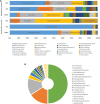Microbiome Composition and Dynamics of a Reductive/Oxidative Bioelectrochemical System for Perchloroethylene Removal: Effect of the Feeding Composition
- PMID: 35923400
- PMCID: PMC9340161
- DOI: 10.3389/fmicb.2022.951911
Microbiome Composition and Dynamics of a Reductive/Oxidative Bioelectrochemical System for Perchloroethylene Removal: Effect of the Feeding Composition
Abstract
Chlorinated solvents still represent an environmental concern that requires sustainable and innovative bioremediation strategies. This study describes the microbiome composition of a novel bioelectrochemical system (BES) based on sequential reductive/oxidative dechlorination for complete perchloroethylene (PCE) removal occurring in two separate but sequential chambers. The BES has been tested under various feeding compositions [i.e., anaerobic mineral medium (MM), synthetic groundwater (SG), and real groundwater (RG)] differing in presence of sulfate, nitrate, and iron (III). In addition, the main biomarkers of the dechlorination process have been monitored in the system under various conditions. Among them, Dehalococcoides mccartyi 16S rRNA and reductive dehalogenase genes (tceA, bvcA, and vcrA) involved in anaerobic dechlorination have been quantified. The etnE and etnC genes involved in aerobic dechlorination have also been quantified. The feeding composition affected the microbiome, in particular when the BES was fed with RG. Sulfuricurvum, enriched in the reductive compartment, operated with MM and SG, suggesting complex interactions in the sulfur cycle mostly including sulfur oxidation occurring at the anodic counter electrode (MM) or coupled to nitrate reduction (SG). Moreover, the known Mycobacterium responsible for natural attenuation of VC by aerobic degradation was found abundant in the oxidative compartment fed with RG, which was in line with the high VC removal observed (92 ± 2%). D. mccartyi was observed in all the tested conditions ranging from 8.78E + 06 (with RG) to 2.35E + 07 (with MM) 16S rRNA gene copies/L. tceA was found as the most abundant reductive dehalogenase gene in all the conditions explored (up to 2.46 E + 07 gene copies/L in MM). The microbiome dynamics and the occurrence of biomarkers of dechlorination, along with the kinetic performance of the system under various feeding conditions, suggested promising implications for the scale-up of the BES, which couples reductive with oxidative dechlorination to ensure the complete removal of highly chlorinated ethylene and mobile low-chlorinated by-products.
Keywords: PCE; bioelectroremediation; chlorinated ethylenes; groundwater remediation; oxidative dechlorination; reductive dechlorination.
Copyright © 2022 Di Franca, Matturro, Crognale, Zeppilli, Dell’Armi, Majone, Petrangeli Papini and Rossetti.
Conflict of interest statement
The authors declare that the research was conducted in the absence of any commercial or financial relationships that could be construed as a potential conflict of interest.
Figures



Similar articles
-
Dehalogenation of Chlorinated Ethenes to Ethene by a Novel Isolate, "Candidatus Dehalogenimonas etheniformans".Appl Environ Microbiol. 2022 Jun 28;88(12):e0044322. doi: 10.1128/aem.00443-22. Epub 2022 Jun 8. Appl Environ Microbiol. 2022. PMID: 35674428 Free PMC article.
-
Correlation of Dehalococcoides 16S rRNA and chloroethene-reductive dehalogenase genes with geochemical conditions in chloroethene-contaminated groundwater.Appl Environ Microbiol. 2010 Feb;76(3):843-50. doi: 10.1128/AEM.01482-09. Epub 2009 Dec 11. Appl Environ Microbiol. 2010. PMID: 20008170 Free PMC article.
-
Chlorinated Electron Acceptor Abundance Drives Selection of Dehalococcoides mccartyi (D. mccartyi) Strains in Dechlorinating Enrichment Cultures and Groundwater Environments.Front Microbiol. 2018 May 17;9:812. doi: 10.3389/fmicb.2018.00812. eCollection 2018. Front Microbiol. 2018. PMID: 29867784 Free PMC article.
-
[Characterization of Reductive Dechlorination of Chlorinated Ethylenes by Anaerobic Consortium].Huan Jing Ke Xue. 2024 Feb 8;45(2):1080-1089. doi: 10.13227/j.hjkx.202302134. Huan Jing Ke Xue. 2024. PMID: 38471945 Chinese.
-
Normalized Quantitative PCR Measurements as Predictors for Ethene Formation at Sites Impacted with Chlorinated Ethenes.Environ Sci Technol. 2018 Nov 20;52(22):13410-13420. doi: 10.1021/acs.est.8b04373. Epub 2018 Nov 8. Environ Sci Technol. 2018. PMID: 30365883 Free PMC article.
Cited by
-
Biodegradable polylactic acid emulsion ink based on carbon nanotubes and silver for printed pressure sensors.Sci Rep. 2024 May 14;14(1):10988. doi: 10.1038/s41598-024-60315-z. Sci Rep. 2024. PMID: 38744852 Free PMC article.
-
Electron Transfer in the Biogeochemical Sulfur Cycle.Life (Basel). 2024 May 6;14(5):591. doi: 10.3390/life14050591. Life (Basel). 2024. PMID: 38792612 Free PMC article. Review.
-
Pilot-Scale Acidogenic Fermentation of Reground Pasta Byproduct for Polyhydroxyalkanoate Production with Mixed Microbial Cultures.ACS Sustain Chem Eng. 2025 Feb 20;13(8):3024-3035. doi: 10.1021/acssuschemeng.4c03754. eCollection 2025 Mar 3. ACS Sustain Chem Eng. 2025. PMID: 40052114 Free PMC article.
-
Electroactive Bacteria in Natural Ecosystems and Their Applications in Microbial Fuel Cells for Bioremediation: A Review.Microorganisms. 2023 May 10;11(5):1255. doi: 10.3390/microorganisms11051255. Microorganisms. 2023. PMID: 37317229 Free PMC article. Review.
-
1,2-DCA biodegradation potential of an aquifer assessed in situ and in aerobic and anaerobic microcosms.Environ Microbiome. 2024 Dec 18;19(1):106. doi: 10.1186/s40793-024-00650-w. Environ Microbiome. 2024. PMID: 39696724 Free PMC article.
References
-
- Altalyan H. N., Jones B., Bradd J., Nghiem L. D., Alyazichi Y. M. (2016). Removal of volatile organic compounds (VOCs) from groundwater by reverse osmosis and nanofiltration. J. Water Process Eng. 9 9–21. 10.1016/j.jwpe.2015.11.010 - DOI
-
- Aulenta F., Reale P., Catervi A., Panero S., Majone M. (2008). Kinetics of trichloroethene dechlorination and methane formation by a mixed anaerobic culture in a bio-electrochemical system. Electrochim. Acta 53 5300–5305. 10.1016/j.electacta.2008.02.084 - DOI
LinkOut - more resources
Full Text Sources

